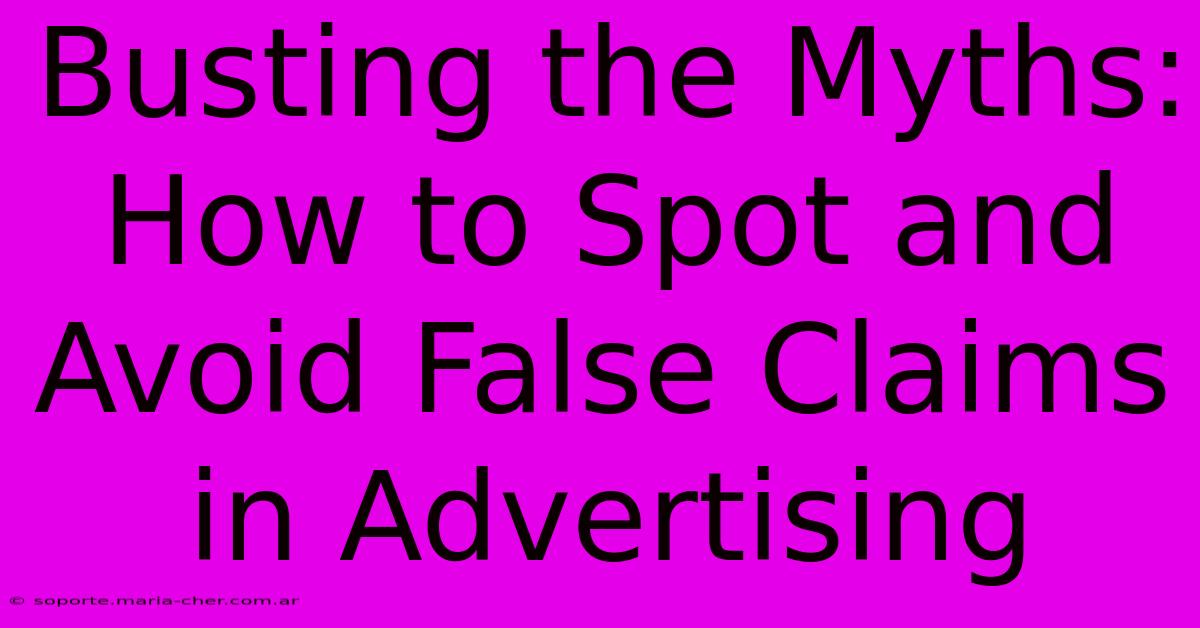Busting The Myths: How To Spot And Avoid False Claims In Advertising

Table of Contents
Busting the Myths: How to Spot and Avoid False Claims in Advertising
In today's digital age, we're bombarded with advertising – from flashy billboards to subtle social media posts. But how much of what we see is actually true? Unfortunately, misleading and false advertising is a persistent problem, designed to manipulate consumers into buying products or services they may not need or that don't deliver on their promises. This article will equip you with the knowledge and skills to identify false advertising and protect yourself from deceptive marketing tactics.
Understanding Deceptive Advertising Tactics
Before we dive into spotting false claims, let's understand the common tricks advertisers use:
1. Vague Language and Unproven Claims:
Beware of advertisements that use ambiguous words like "improved," "enhanced," or "all-natural" without providing concrete evidence. Claims lacking scientific backing or specific details are often red flags. For instance, a weight-loss product claiming "rapid results" without mentioning specific weight loss or the timeframe is highly suspicious.
2. Misleading Comparisons and Statistics:
Advertisements frequently use misleading comparisons. A product might claim to be "50% better" than the competition without specifying what aspect is 50% better. Similarly, manipulating statistics or presenting them out of context can create a false impression. Always look for the source of the statistics and scrutinize the methodology.
3. Hidden Fees and Fine Print:
Many advertisements cleverly hide crucial information in the fine print. Read carefully before committing. Watch out for hidden fees, additional charges, or restrictive terms and conditions that are not prominently displayed.
4. False Testimonials and Endorsements:
Fake testimonials or endorsements from celebrities or supposed experts can be incredibly persuasive. Be wary of testimonials that seem too good to be true or lack verifiable sources. Look for evidence of genuine user reviews from reputable platforms.
5. Bait-and-Switch Tactics:
Bait-and-switch tactics involve advertising a product at a low price to attract customers, only to switch them to a more expensive product once they're committed. If a deal seems too good to be true, it probably is. Confirm the advertised product's availability before making a purchase.
How to Spot False Advertising:
Here are some practical tips to help you identify false advertising claims:
- Verify the claims: Don't rely solely on the advertisement. Research the product or service independently. Check reviews on reputable sites, compare prices, and look for independent testing or verification.
- Look for evidence: Ask for evidence to support claims. Reputable companies will be able to provide data, research, or testimonials to back up their marketing statements.
- Be wary of "guarantees": While guarantees can be a good sign, be aware that many are riddled with loopholes or conditions. Read the fine print carefully.
- Check the source: Consider the credibility of the source. Is the advertisement from a known and trusted company, or is it from an unknown or disreputable source?
- Report suspicious advertising: If you believe you've encountered false advertising, report it to the relevant authorities. Many countries have consumer protection agencies that handle complaints about misleading advertising.
Protecting Yourself from Deceptive Marketing:
- Do your research: Before making any purchase, take the time to research the product or service thoroughly. Read reviews, compare prices, and check for independent verification of claims.
- Be skeptical: Don't believe everything you see or hear. Approach advertising with a healthy dose of skepticism and critically evaluate the information presented.
- Read the fine print: Always read the terms and conditions, warranties, and disclaimers carefully before making a purchase or signing a contract.
- Compare prices: Don't jump at the first offer you see. Compare prices from different providers to ensure you're getting a fair deal.
- Trust your instincts: If something feels too good to be true, it probably is.
By understanding the tactics used in deceptive advertising and following the tips outlined in this article, you can become a more informed and discerning consumer, better equipped to avoid false claims and make sound purchasing decisions. Remember, your consumer rights are important, and you deserve accurate information when making purchasing choices.

Thank you for visiting our website wich cover about Busting The Myths: How To Spot And Avoid False Claims In Advertising. We hope the information provided has been useful to you. Feel free to contact us if you have any questions or need further assistance. See you next time and dont miss to bookmark.
Featured Posts
-
Vyravnivayte Obrezayte Izmenyayte Razmer Vse Chto Nuzhno Dlya Sovershennykh Fotografiy
Feb 07, 2025
-
The All In One Mecca Discover A Site That Has Everything You Ve Ever Desired
Feb 07, 2025
-
Garden Or Garment Sewed Or Sowed The Grammar Dilemma
Feb 07, 2025
-
Tech Gurus Top Pick Sony Alpha 300 The Dslr That Breaks Boundaries
Feb 07, 2025
-
Ph Ds For The 21st Century Bridging The Gap Between Youth And Wisdom
Feb 07, 2025
